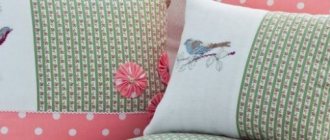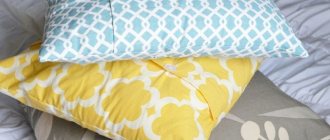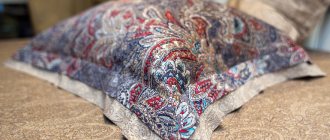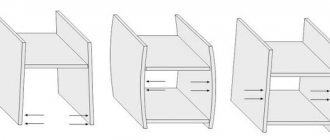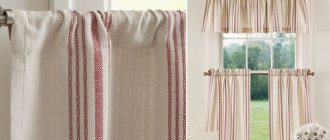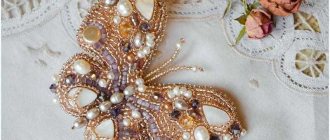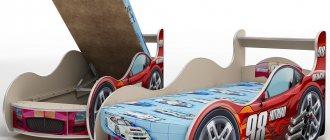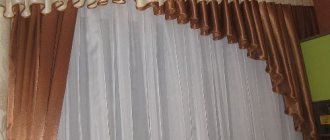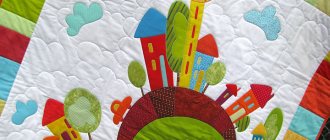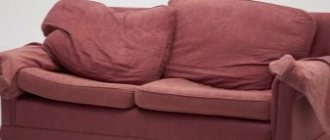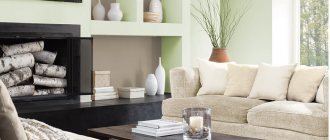Gone are the same type of massive pillows with feather fillings, which our grandmothers carefully shook and carefully placed on the beds. Today, smaller pillows have become fashionable, and various artificial and natural fibers can serve as filler. And although the procedure for caring for them remained the same, the pillowcases for them acquired new, improved elements, one of which is a zipper.
Beautiful sofa cushions are rightfully considered a full-fledged decorative element in the interior.
Materials for sewing a pillowcase with a zipper
- Textile. Before sewing pillowcases, it is better to wash the fabric so that it shrinks before work. The choice depends only on your taste and purpose of the pillow: for a decorative pillow, a more colorful fabric is suitable, for a child, the appropriate children's colors are suitable. What fabric to sew from?
- One zipper for bed linen is 10 cm shorter than the side of the pillow.
- Threads of a suitable color.
- Common sewing supplies such as a sewing machine, scissors and pins.
How to sew a zipper into a pillow cover
In order to keep the fabric of the pillowcase of your favorite pillow clean and keep it as much as possible from contamination, resourceful housewives try to put a cover on it under the pillowcase. Today, such covers can already be purchased in any store, in the “bedding” department. But there is nothing easier than sewing a cover with a zipper for a sofa cushion with your own hands.
The main thing is to choose the right fabric.
First of all, cut out two parts from the fabric - front and back.
The sewing procedure itself is much simpler. If you need to use an overlocker to sew a pillowcase, then it is not necessary to process the cover.
The top side of the zipper should be turned right side out, with the teeth facing up, and the bottom side should be parallel to it.
Using the zipper foot on your sewing machine, start stitching along the long side.
The exception is the cover, which will be sewn from different pieces of fabric. Especially if such a cover is intended for large sofa cushions.
Important! Be sure to steam iron all seams before sewing all edges on the garment. You can also secure the seams with a finishing stitch at 0.6 - 0.8 cm.
Finish sewing 2.5 cm before the end of the opposite edge.
Start sewing again just above the zipper, closing the hole. Repeat on the other side.
By choosing two different fabrics in color and texture for a sofa cushion cover, you can achieve uniquely beautiful results.
Carefully cut off the excess length of the zipper.
You should not sew in a metal zipper or a “tractor” zipper. For the case, it is better to choose a one-piece twisted zipper, which can be shortened if necessary.
Turn the pillowcase right side out and insert the ends of the zipper into the hole.
Your pillowcase is ready!
At the final stage of sewing, be sure to iron all the seams again, carefully straighten it and put it on the sofa cushion.
Having learned how to sew pillowcases with a zipper, it is not at all difficult to create decorative pillowcases for armchairs and sofas.
Final step: Overlock the edge
To do this, we perform the standard procedure with the appropriate nozzle. That's it, our product is ready.
Pillowcases with a zipper are very easy to remove and wash. And if you do this often, you will have to make sure that the edge is processed efficiently. Otherwise they won't last long.
If you don't have a serger, you can make a zigzag stitch and run the machine along the edge so that the needle goes through the fabric on one side and barely catches the outside of the fabric.
conclusions
Knowing all the secrets of how to properly sew a zipper into a pillowcase or pillow case, every housewife will be able to cope with this work independently. Using your design imagination, you can easily sew uniquely interesting types of pillowcases from fabrics of different textures, coming up with a variety of design elements. A zipper on the products will make the pillow not only more attractive and neat, but also convenient during use. Select high-quality zippers up to 70 cm long. Cut off the excess piece of zipper at the final stage of sewing.
Progress
- Cut out the details of the pillowcase - two rectangles. The sides of the pattern should be 2 cm larger than the dimensions of the finished pillow on each side.
- Align the treated sides and pin them together. This is where the fastener will be sewn in.
Advice. It is convenient to use long and thin tailor's pins instead of basting parts. To prevent them from interfering with stitching the parts, they should be attached perpendicular to the stitching.
- Determine the middle on the zipper and the working side of the rectangle, mark the place in the middle with a marker.
- Align the center marks on the pattern and the lock.
- Mark the end and beginning of the zipper with pins on the material. Do not pin the zipper.
Determine the location for the zipper
Tip. The zipper begins and ends along the teeth, not at the edges of the tape.
Check the edges match:
- Check that the edges and corners of the fabric match exactly before sewing.
- Stepping back 1 cm, sew along the side line from the edge to the mark on both sides.
- Between the pins, sew the patterns with the widest straight step or the widest zigzag, so that later you can easily remove the thread.
Iron the seam
- Iron the seam.
Align the zipper and seam
Place the zipper in its rightful place:
- Place the clasp right side down on the seam from the inside out. Align the seam line and the longitudinal line of the zipper as accurately as possible. Fix the position of the parts with needles.
Advice. While working, do not pull the fabric too tightly, otherwise the braid will become lumpy after stitching.
- Change the stitch on the machine from wide to regular (in increments of 2 mm).
- Sew in the zipper by placing a stitch around the fastener.
Sewing the lock
Tip. If a regular foot is used, then the stitching is laid as close to the teeth as possible.
- Having reached the lock, raise the machine foot. In this case, the needle is lowered down to hold the fabric. Carefully unfasten the lock, move it by the foot, lower the clamping mechanism and continue stitching, moving along the perimeter of the fittings. At the end, take a final step.
- Turn the work right side out and carefully remove the temporary marking in the middle. The opened seam will contain the working mechanism of the lock. It should be easy to unfasten and not bend with a wave.
Methods for securing a lock
The method of sewing in a zipper will depend on its type, product, fabric and the place where it will be located. In the case of a pillowcase, you can use several sewing options.
- In the side seam.
- In the middle of one side of the pillowcase.
Lock in the middle of the pillowcase
- Sew a regular fastener, covering it with a flap.
Pillowcase with zipper under flap
- Insert an open regular fastener with a contrasting ribbon in the middle of the product as a decorative element
Contrast zipper
Padding
Read more about stuffing. First of all, you need to look at the properties of the filler itself, since this is the main characteristic of the future pillow. You can stuff the product with padding polyester or knitted tape, cotton wool and other materials that are quite cheap. In cases where stuffing is required specifically for a decorative model, it is important to approach the process of choosing filler more seriously.
You may be interested in this: Making patterns and sewing elephant toys
Appearance of holofiber
The main properties that the material must have:
- Sufficient elasticity. When pressed, the product should quickly restore its shape and not leave dents if people sleep on it;
- Breathability. All materials, including those from which the base, cover and padding are made, must allow air to pass through well and allow the skin to breathe;
- Hypoallergenic. All these materials must also be safe for human health and not cause allergies or skin irritation;
- Easy to care for. The pillowcase, cover and pillow itself should be easy to wash and machine washable.
Sintepon
By type, padding is divided into three categories:
- Artificial material;
- Natural material of plant origin;
- Natural material of animal origin.
Hop cones for stuffing
Artificial padding
Artificial materials have a number of properties that put them on the same level as natural ones. Moreover, they also have their own distinctive characteristics. This composition does not allow dust mites to develop and will not cause allergies. Synthetic materials are easier to wash and dry quickly.
Foam pillow
The most commonly used artificial paddings are padding polyester and holofiber. The first option is budget. Sintepon is used not only for this, but also in the manufacture of clothing.
Important! A significant disadvantage of padding polyester is that it quickly falls into clumps and does not recover its shape well. If such a pillow is actively used, then tubercles will quickly appear on it, and its surface will become hard.
Pillow in the shape of a scops owl
That is why the best choice would be holofiber, a non-woven material consisting of interwoven polyester fibers. The space between the fibers has a porous structure and is filled with air, which makes holofiber light and warm. In addition, the composition has the following characteristics:
- Removal of moisture and water;
- Air permeability;
- High service life;
- No static electricity;
- Easy to care for and easy to machine;
- No smell.
Toy pillows in the form of cats
Vegetable stuffing
Plant materials are often used to form decorative pillows or sleep products. Among the most popular options:
- Dry herbs and algae;
- Leaves of herbs such as mint or lemon balm;
- Hop cones;
- Buckwheat husk.
Herbs can also be used as a filler
. Important! In many cases, such stuffing will be beneficial to health, will add some originality to the product and a pleasant smell of herbs, which will spread throughout the room.
Cotton is also often used. A pillow stuffed with cotton will be hypoallergenic, and harmful organisms and insects will not breed in it. If you stuff the cotton correctly and take care of the pillow, you can extend its service life.
Product with cotton
Animal stuffing
Down and feathers from birds (chicken, geese, swans, ducks) are considered traditional for animal stuffing. The pillows are light, soft, and quickly take shape after deformation. One drawback is that it is not advisable for people suffering from dust mite allergies to sleep on them. The thing is that over time, microorganisms can develop in such stuffing that can cause suffocation attacks in allergy sufferers. But this can also be avoided. It is enough to properly care for the item, constantly wash, dry and air it.
Sheep wool padding
In addition, you can stuff the pillow with camel or sheep wool. It will become not only comfortable, but also therapeutic, because camel hair helps people suffering from radiculitis get rid of symptoms. This material also has disadvantages: heavy weight and rapid rolling.
You might be interested in How to make a rose from foamiran using a finished pattern
Important! You can also use unnecessary pieces of wool yarn or an old fur coat. It can be cut into pieces and distributed evenly over the base. Such a pillow will collect a lot of dust, so it should be washed or knocked out more often.
Camel hair pillow
What tools will you need?
Tools are prepared in relation to what the design element will be made of and what shape it will be. If you want to knit a base, then, of course, you will need knitting needles or a hook and yarn. For decoration the following will come in handy:
- Needle, thread, sewing machine;
- Paper, tracing paper or cardboard for the diagram;
- Chalk or soap, a special pencil;
- Scissors.
It is important that the color of the pillow matches the overall design of the room.
Decoration
Now you can start decorating your sleeping accessories. The product can be decorated:
- lace;
- sequins;
- embroidery;
- multi-colored ribbons;
- yarn;
- applications;
- folds and so on.
It all depends on your imagination and capabilities.
Decoration options
There are various options for decorating pillowcases.
Romantic shabby chic
This design style (shabby gloss) came to us from England. It is quite romantic and suitable for the same people. When creating a design in the shabby chic style, it is impossible to do without a large number of pillows embroidered with various patterns. Here you can use small, cute, as well as large, fluffy heart-shaped pillows.
Buying such designer pillows is an expensive and unreasonable pleasure. To obtain decorative items in a romantic style, you need to arm yourself with suitable materials and your imagination.
Puffs are quite an interesting decoration for pillows. They are made according to a strict geometric shape and are made up of several identically made rows.
Buffs are divided into several types. Products designed with their help look quite luxurious, bright and unusual. Every novice needlewoman can make similar finishes for decorative pillows. Here you will need to develop a pattern and a reserve of patience, because such decoration is a long and painstaking work.
Embroidery ribbons
Products embroidered with ribbons look original and cute. In this way you can sew various patterns. Decorating with ribbons is a very simple task that does not require professionalism.
Applications
Creating interesting pillows using appliqué is an easy job. You can independently make round emoticons with different emotions, products in the form of letters, and also combine several techniques at once. Here everything depends on the imagination of the needlewoman: you can combine knitting and embroidery with ribbons, appliqué techniques and puffs.
When sewing pillowcases, don't be afraid to experiment. By creating a comfortable environment in your home yourself with the help of unusual products, you can get rid of any financial expenses, while surprising your loved ones with cute homemade gifts.
Source
Tips for beginning needlewomen
The following useful tips from “crazy hands” will help you create decorative masterpieces:
- For unusually shaped pillows, it is better to use patterns that will help you cut out the material efficiently.
- Remember that secret locks made of plastic are most suitable for pillowcases. Metal ones will not be as convenient to use.
- Before cutting, measure the prepared fabric several times according to the principle “measure twice, cut once.”
- It is best to secure the parts with American pins, as they are thin and do not interfere under the sewing machine foot. Removing them from the seam will not be difficult.
- To keep the corners neat, sew them diagonally. Leave 1 centimeter before finishing the straight stitch. Leave the needle in the fabric and raise the foot. Unfold the fabric at an angle of 45 degrees and sew the side seam. Process each corner in this manner, then cut off the remaining allowances.
